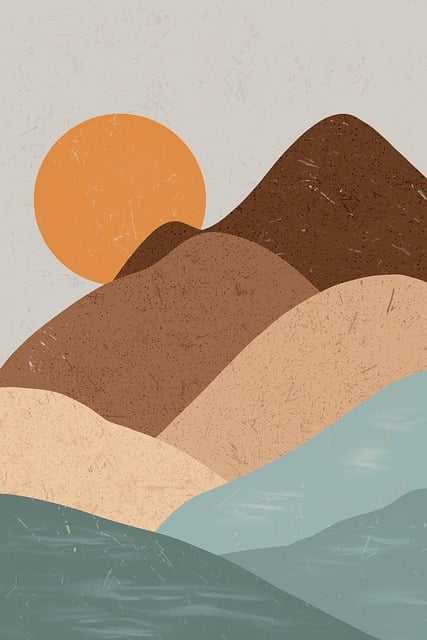Table of Contents
- Exploring the Evolution of Landscape Art Through the Ages
- Techniques and Styles: Mastering the Art of Capturing Nature
- Choosing the Right Palette: Colors that Bring Landscapes to Life
- Incorporating Landscape Art into Your Home Decor: Tips and Inspirations
- Q&A
- To Conclude
Exploring the Evolution of Landscape Art Through the Ages
The journey of landscape art is a fascinating reflection of humanity’s relationship with nature, evolving from primitive expressions to intricate masterpieces. In ancient times, landscapes were often depicted in frescos and cave paintings, showcasing the natural world as an exquisite backdrop to human events. Early artists like the Greeks and Romans began to embrace perspective, using backgrounds not just as settings but as critical narratives in their art. They laid the groundwork for future movements by bridging the gap between the human experience and its environment.
As we moved into the medieval period, the representation of landscapes began to take on a more spiritual aspect. Artists utilized vibrant colors and stylized forms to convey the divine in nature. Gothic cathedrals often included stained glass windows that depicted landscapes alongside biblical stories, infusing a sense of otherworldliness into the earthly scenery. This era demonstrated how landscapes could serve a purpose beyond simply capturing images—they began to embody messages of faith and hope.
The Renaissance marked a significant turning point, ushering in an age where artists like Leonardo da Vinci and Michelangelo explored landscapes with a renewed sense of realism. Here, artists focused on accurate depictions of nature, employing techniques such as chiaroscuro and atmospheric perspective. This emphasis on realism enabled artists to incorporate detailed landscapes that not only enhanced the composition but also reflected the cultural values of the time. The landscapes in this period often featured serene countryside scenes and dramatic mountains, inviting the viewer to lose themselves in these idyllic environments.
In the subsequent centuries, various art movements such as Romanticism, Impressionism, and Post-Impressionism further transformed landscape art. Romantic artists like Caspar David Friedrich emphasized emotion and the sublime beauty of nature, while Impressionists, such as Claude Monet, focused on the effects of light, capturing fleeting moments in their landscapes. Each movement contributed to an evolution in technique and perception, solidifying landscape art as an integral aspect of Western art history. The diverse styles and philosophies of these movements continue to inspire contemporary artists, reflecting our ever-evolving relationship with the world around us.


Techniques and Styles: Mastering the Art of Capturing Nature
When it comes to landscape art paintings, the techniques and styles an artist chooses can significantly impact the viewer’s experience. Impressionism remains a favored style among landscape artists, primarily for its focus on light and its ephemeral qualities. Characteristics such as soft brush strokes and vibrant color palettes enable artists to convey the mood of a scene, allowing the viewer to feel as if they are standing within the landscape. This technique emphasizes the transient nature of light, making every moment captured seem alive and pulsating with energy.
Another technique gaining traction is plein air painting, where the artist paints outdoors, capturing the raw beauty of nature in real-time. Its spontaneity makes it particularly appealing, as artists translate their immediate surroundings onto the canvas, often using a limited palette for a more harmonious look. The process encourages a deep connection with the environment, enabling artists to observe minute details in the changing landscape. This technique not only hones observational skills but also fosters a profound appreciation for the natural world.
Beyond these styles, the use of color theory plays a vital role in landscape paintings. Artists experiment with color contrasts and harmonies to encapsulate the essence of a landscape. Understanding how colors interact can enhance emotional responses; for example, warm hues can evoke feelings of warmth and comfort, while cooler shades might elicit tranquility or melancholy. The following table illustrates key color pairs often used in landscape art to evoke various emotions:
| Color Pair | Emotion Evoked |
|---|---|
| Warm Reds & Oranges | Energy and Passion |
| Cool Blues & Greens | Calmness and Serenity |
| Earthy Browns & Greens | Stability and Comfort |
| Soft Pastels | Nostalgia and Dreaminess |
To further master landscape painting, artists turn to composition techniques such as the rule of thirds, leading lines, and framing. The rule of thirds suggests dividing the canvas into a grid to create a balanced composition, while leading lines draw the viewer’s eye into the painting, emphasizing depth and perspective. Framing involves using natural elements like trees or rocks to isolate the focal point, creating a sense of intimacy within the vastness of nature. Understanding and applying these techniques can transform a simple landscape into a captivating and immersive visual narrative.


Choosing the Right Palette: Colors that Bring Landscapes to Life
When it comes to creating landscape art, choosing the right color palette is essential for capturing the essence of the scenery. Each color holds the power to evoke specific emotions and convey different atmospheres, breathing life into your artwork. As you embark on your artistic journey, consider the following guidelines to help you select the most effective colors:
- Study the Environment: Before dipping your brush in paint, take a moment to observe the landscape closely. Note how colors change throughout the day and in various seasons. This will lay the groundwork for understanding how to translate nature’s palette onto your canvas.
- Use a Color Wheel: A color wheel can be invaluable in selecting harmonious color combinations. Complementary colors can add depth and vibrancy, while analogous colors can create a soothing blend.
- Experiment with Temperature: Colors have intrinsic temperatures; warm colors like reds and yellows can create a sense of warmth and energy, while cool colors such as blues and greens can evoke tranquility. Play with these temperatures to enhance the mood of your landscape.
- Consider Light and Shadow: How light affects colors is crucial in landscape painting. Shadows can deepen hues and create contrast, while highlights can bring brightness and focus. Understanding this relationship will help you create a more dimensional and engaging work.
As you refine your color choices, think about how they will interact not just with one another but with the viewer as well. The emotional response elicited by your palette can dramatically shift awareness and context within your art. A serene blue sky contrasted with a vibrant sunset can transport the viewer to that tranquil moment, while bold, saturated colors can energize a scene.
Incorporating textures and tones into your palette can also elevate the realism of your landscape paintings. Consider the following elements in your work:
| Texture | Color Choice | Effect |
|---|---|---|
| Soft Clouds | Light pastels | Calm and peaceful ambiance |
| Rustling Leaves | Rich greens | Vibrancy and life |
| Pebbly Path | Earthy browns | Grounded and organic feel |
| Flowing Water | Translucent blues | Fluidity and motion |
Ultimately, the journey of selecting a color palette for landscape painting is as personal as the act of painting itself. Embrace the experimental nature of this process and trust your instincts. Each stroke can lead you to unforeseen creative paths, illuminating not only the landscape but also your unique artistic voice.


Incorporating Landscape Art into Your Home Decor: Tips and Inspirations
Integrating landscape art into your home decor can transform your space into a serene retreat. The natural beauty captured in these pieces brings a fresh perspective and a calming atmosphere, making them perfect for any room. Consider selecting art that features not only vibrant colors but also unique textures that mimic nature. Opt for framed canvases or oversized prints to create a bold statement on your walls.
When choosing landscape art, think about the color palette of your room. Harmonizing the artwork with existing decor can create a cohesive look. For example, if your living room boasts warm tones, seek out landscapes that include sunsets or autumnal scenes. On the other hand, cooler shades can enhance spaces filled with natural light, reflecting the outdoors. To help visualize your choices, here’s a simple table to guide your color selection:
| Room | Suggested Landscape Art Themes | Color Palette |
|---|---|---|
| Living Room | Sunset Views | Warm oranges, reds, and yellows |
| Bedroom | Mountain Landscapes | Cool blues and greens |
| Home Office | Forest Scenes | Earthy browns and soft greens |
Don’t be afraid to mix and match styles for an eclectic look. Combine traditional landscapes with contemporary pieces to create a gallery wall that speaks to your personality. Pair abstract landscapes with photographs for added depth, or frame smaller pieces together in a grid layout. This technique enhances visual interest and draws attention to the artwork.
Lastly, consider the placement of your landscape art. Above furniture like sofas or mantels is a classic location to make an impact. You could also embrace less conventional spaces, such as hallways or entryways, to surprise guests with unexpected beauty. Incorporating landscape art into niche areas or alongside plants can also enhance the natural vibe of your home, creating an inviting and harmonious environment.
